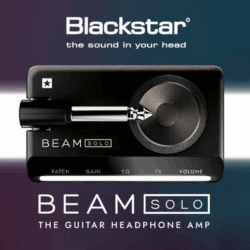
Blackstar Announces BEAM SOLO – Play Time.
At Blackstar, we believe great tone should be ready whenever inspiration strikes. That’s why we created BEAM SOLO — the most immersive, intuitive headphone amp on the market today. Whether you’re jamming at home, on the move, or just grabbing ten minutes of play time between everything else, BEAM SOLO gives you pro-level sound with complete creative freedom — wherever you are.Designed for electric, acoustic and bass guitars, BEAM SOLO fits in your hand, plugs straight into your headphones, and delivers the sound and feel of a real amp. You can shape your tone directly on the unit using the tactile SpeedDial and Light Beam Display, which give instant visual feedback with no menus to navigate. Or you can take full control through the BEAM app, where a growing library of professional-grade amp, cab, mic and pedal models is waiting. Combined with our patented ISF, you can access an infinite number of tonal possibilities to explore, enjoy and create with. With our unique and immersive ‘In The Room’ technology, we’ve made the headphone experience feel alive — like a real amp, in a real space. Every note resonates with depth and presence, making even silent practice inspiring. A single expressive control called XpressFX lets you control multi-layered effects in real time, with smooth transitions that feel natural when adjusting. We’ve also added a headset mic input with studio-quality preamps and reverb, so you can truly immerse yourself with both guitar and vocals wherever you are, and jam along to your favourite tracks seamlessly via Bluetooth audio.In addition to the authentic Blackstar amp models, BEAM SOLO also includes Ampton – our collection of classic software amplifiers, designed at Blackstar HQ in Northampton UK – home to our world-class R&D department. Built on decades of experience in both valve and digital amplifier design, Ampton fuses authentic valve character with advanced digital algorithms, developed by a design team with a unique technical heritage. The name itself is drawn from Northampton, reflecting the roots of our engineers and the history behind the company.Ampton designs are more than just static profiles, they are the result of meticulous design, testing and optimisation – component by component, sector by sector. Starting with Blackstar founder Bruce Keir’s original digital models of our legendary Series One valve amplifiers, every element has been refined over decades. This dedication extends to the tiniest tonal interactions, from cathode follower behaviour to the modelling of preamp DC offsets, ensuring unmatched realism, tone and feel.Another unique aspect of the Ampton designs are the completely accurate tone-stack models. These retain the exact interactivity between controls as the valve amp references, to deliver musicality and interactivity that a mere “capture” snapshot cannot. The power amplifier models go beyond traditional emulation, recreating the true interplay between valves, output transformers and speakers.Our method blends deep analysis and literally hundreds of hours of critical listening. AB sonic tests are matched with precise electrical analysis, while the design team use their decades of voicing expertise. Every nuance is considered while intelligent optimisation results in elegant algorithms with extremely low latency.If you head over to the BEAM app, you’ll find Official Artist Patches to explore from an ever growing list of all-stars including Doug Aldrich (The Dead Daisies), Gus G. (Firewind), Will Sergeant (Echo & The Bunnymen) and many more. You can join in the fun and share your own tones on the online community and download other creators’ patches within a vibrant global community of players just like you. You can even share your favourite patches over message to your friends with just a simple tap.Within the ‘Music’ section of the app, you’ll find a host of backing tracks and video lessons to make sure that you can stay inspired and continue your learning journey. The BEAM SOLO is a complete one-stop solution for guitar players today.We designed BEAM SOLO to give every guitarist the freedom to play and create anywhere, instantly, and without compromise. Whether you’re shaping your sound with a twist of the SpeedDial or diving deep into your rig choices via the app, it always feels intuitive and immersive. You can record vocals, jam with backing tracks, or just enjoy the feel of a cranked valve amp in your headphones — all from a device that fits in your pocket.We’re constantly adding new sounds and features to the BEAM app, so your rig evolves with you. With ISF, XpressFX, SpeedDial, Light Beam Display and community connectivity, BEAM SOLO gives you the tools to stay inspired, have fun and sound incredible — wherever you are.
Read more »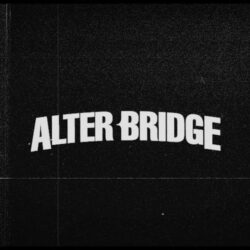
Alter Bridge Release First Track/Video “Silent Divide”
On the heels of the excitement from the recent announcements of their upcoming 8th studio album and their Blackbird festival in Wales next summer, acclaimed rockers Alter Bridge are releasing the first piece of music in over two years, “Silent Divide.” The track from the quartet comprised of Myles Kennedy on vocals/guitars, Mark Tremonti on guitars/vocals, Brian Marshall on bass and Scott Phillips on drums shows the band is back and ready to pick up where they left off in 2023. The brooding track begins with the signature guitar tones of Kennedy and Tremonti before the rhythm section of Marshall and Phillips join in. The chorus is powered by Kennedy’s haunting descent as he sings: “Keep your head down, ride out the silent divide.” A music video for “Silent Divide” is also available today that the band has been teasing for days. A comedic opening skit was released of Tremonti, Marshall, and Phillips calling Kennedy’s mom to get the band back together as Myles hangs in his mom’s basement. That scene gives way to a performance of the 4 guys playing together in a small room – a throwback to the way it all started for them. The video was directed by JT Ibanez, and the song can be found in all formats here:
With more than two decades performing together, Alter Bridge show no signs of slowing down. The new, self-titled album from Napalm Records, Alter Bridge, is comprised of 12 all new tracks from the band and features some of their most iconic moments on record. Songs like “Rue The Day,” “Disregarded” and “Scales Are Falling” will fit alongside any of the classic songs from Alter Bridge’s catalog. “Trust In Me” shows Myles and Mark sharing vocal duties as Myles handles the verse duties while Mark takes the chorus. That strategy is flipped on “Tested And Able” as Mark handles the verses and Myles takes on the choruses behind one of the band’s heaviest intros to date, giving way to an unforgettable melody. The album closer “Slave To Master” is an epic track that Alter Bridge has come to be known for and is the longest song the quartet has recorded to date. The band worked with longtime collaborator and producer Michael “Elvis” Baskette on their eighth album. Alter Bridge will be released on January 9, 2026, and is now available for pre-order at: https://www.lnk.to/AB-AlterBridge.
The track listing for Alter Bridge is:1) Silent Divide (5:06) 2) Rue The Day (4:46) 3) Power Down (4:08) 4) Trust In Me (4:48) 5) Disregarded (3:55)6) Tested And Able (4:36) 7) What Lies Within (5:07) 8) Hang By A Thread (4:11) 9) Scales Are Falling (5:54) 10) Playing Aces (4:05) 11) What Are You Waiting For (5:00) 12) Slave To Master (9:03)To coincide with the release of the new music, Alter Bridge is announcing a headline U.S. tour to accompany their already announced European tour. The band is heading out on the What Lies Within U.S. Tour featuring Filter or Sevendust and Tim Montana as support in select markets. The tour kicks off on April 25 in Orlando, FL and runs through May 24 where it wraps in Tampa, FL. Along the way, the tour will make stops in Dallas, TX (April 29), Chicago, IL (May 6) and Huntington, NY (May 12) to name a few. More information on all tickets and VIP packages for the upcoming tour can be found at www.alterbridge.com.What Lies Within U.S. Tour
Apr 25 – Orlando, FL – House of Blues – TMApr 26 – Atlanta, GA – Coca-Cola Roxy – 7D/TMApr 28 – Houston, TX – Bayou Music Center – F/TMApr 29 – Dallas, TX – South Side Ballroom – F/TMMay 1 – Tulsa, OK – Skyline Event Center at Osage Casino Hotel – F/TMMay 2 – Omaha, NE – Steelhouse Omaha – F/TMMay 5 – Green Bay, WI – EPIC Event Center – F/TMMay 6 – Chicago, IL – The Salt Shed – F/TMMay 9 – Atlantic City, NJ – Event Center at Borgata Hotel Casino & Spa – FMay 10 – Boston, MA – Citizen House of Blues Boston – F/TMMay 12 – Huntington, NY – The Paramount – F/TMMay 13 – Montclair, NJ – The Wellmont Theater – F/TMMay 18 – Pittsburgh, PA – The Roxian Theatre – F/TMMay 19 – Detroit, MI – The Fillmore Detroit – F/TMMay 21 – Nashville, TN – The Pinnacle – 7D/TMMay 22 – Birmingham, AL – Avondale Brewing Company – F/TMMay 24 – Tampa, FL – Seminole Hard Rock Tampa Event Center – F/TMPreviously announced What Lies Within Tour Dates
Jan 15 – HAMBURG, GERMANY – Sporthalle Jan 17 – OSLO, NORWAY – Sentrum SceneJan 18 – OSLO, NORWAY – Sentrum SceneJan 20 – STOCKHOLM, SWEDEN – Annexet Jan 22 – HELSINKI, FINLAND – Ice Hall Black BoxJan 24 – COPENHAGEN, DENMARK – KB HallenJan 25 – BERLIN, GERMANY – Columbiahalle Jan 27 – GLIWICE, POLAND – Prezero Arena GliwiceJan 28 – BUDAPEST, HUNGARY – Barba Negra Jan 30 – VIENNA, AUSTRIA – Gasometer Jan 31 – ZAGREB, CROATIA – Bocarski DomFeb 02 – ROME, ITALY – Atlantico Feb 03 – BERGAMO, ITALY – ChorusLive ArenaFeb 05 – ZURICH, SWITZERLAND – The HallFeb 06 – LYON, FRANCE – Halle Tony GarnierFeb 08 – BARCELONA, SPAIN – Razzmatazz 1Feb 10 – LISBON, PORTUGAL – Sagres Campo PequenoFeb 12 – MADRID, SPAIN – Palacio VistalegreFeb 13 – BORDEAUX, FRANCE – Arkea ArenaFeb 15 – LUXEMBOURG, LUXEMBOURG – Rockhal Feb 17 – OBERHAUSEN, GERMANY – Oberhausen TurbinenhalleFeb 18 – PARIS, FRANCE – Zenith Feb 20 – MUNICH, GERMANY – Zenith Feb 22 – AMSTERDAM, NETHERLANDS – Ziggo DomeFeb 23 – BRUSSELS, BELGIUM – Ancienne BelgiqueFeb 25 – NEWCASTLE, UNITED KINGDOM – Utilita Arena Feb 26 – MANCHESTER, UNITED KINGDOM – AO ArenaFeb 28 – DUBLIN, IRELAND – 3Arena Mar 02 – GLASGOW, UNITED KINGDOM – OVO Hydro Mar 04 – LONDON, UNITED KINGDOM – The O2Mar 05 – NOTTINGHAM, UNITED KINGDOM – Motorpoint ArenaJun 27 – CARDIFF, WALES – Blackbird Festival @ Cardiff CastleBack in 2004, four lifelong musicians got together down in Florida. Even though they had traveled separate paths, similar lessons learned, wisdom earned, and dues paid united these gentlemen—Myles Kennedy [vocals, guitar], Mark Tremonti [guitar, vocals], Brian Marshall [bass], and Scott Phillips [drums]—as Alter Bridge. Over the ensuing two decades, the band endured countless trials and tribulations, defied every odd, and rose to the head of the pack as a hard rock juggernaut, cementing a singular legacy by selling out arenas, gathering nearly 1 billion streams, inciting international acclaim, and quietly attracting a diehard audience. Beginning with the Top 5 entry of 2004’s gold certified One Day Remains, the band have scored six consecutive Top 20 debuts on the Billboard 200. Among a myriad of highlights, Guitarist Magazine applauded “Blackbird” for the “Greatest Guitar Solo of All Time,” the ABIII single “Isolation” vaulted to #1 on the Billboard Mainstream Rock Chart, 2013’s Fortress received rare perfect scores from KERRANG! and Total Guitar, and Walk The Sky shook the Top Rock Albums Chart at #1. Beyond packing O2 Arena and Royal Albert Hall, Classic Rock hailed 2022’s Pawns & Kings as “the Rolls-Royce of Alter Bridge records” in a 4.5-out-of-5-star review. Plus, the latter LP garnered praise from American Songwriter, Guitar World, and Loudwire, while Billboard christened them “one of America’s premiere hard rock quartets.” Channeling the same hunger, the band continue to push themselves on their self-titled eighth full-length offering, Alter Bridge [Napalm Records]. It embodies everything they’re known for such as the precise riffs, towering hooks, and solos that practically break guitar strings as they burst through the clouds.
Video Premiere: Prisoner – “Double Vision”
Watch Calgary’s Prisoner, crank the amps and swing for the fences with their new video for “Double Vision.”
The post Video Premiere: Prisoner – “Double Vision” appeared first on Decibel Magazine.
Track Premiere: Elepharmers – ‘Drifter’
Hear a new jam from Italian stoner metal trio Elepharmers from their forthcoming Western Wilderness LP.
The post Track Premiere: Elepharmers – ‘Drifter’ appeared first on Decibel Magazine.
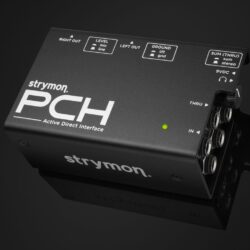
Strymon Introduces New PCH Stereo Active DI
Strymon Engineering has introduced the new PCH Stereo Active Direct Interface, an advanced stereo direct box with a built-in headphone amplifier.Featuring impressive specs that out-perform DIs anywhere near its price range, PCH also has a unique feature expected to delight pedalboard users: a powerful built-in headphone amp, loud and clean enough to drive even high impedance headphones. Now you can rest easy knowing that the sound of your pedalboard won’t change even a little when passing through PCH, and the headphone amp means you won’t have to ask anyone how you sound. You’ll know.
PCH makes it easy to monitor or practice while listening to the sound of your entire rig or pedalboard in full stereo. No matter what instrument or style of music you play, if you need to connect unbalanced outputs to a PA, recording interface or flat response speaker system, PCH is the ultimate choice for an absolutely transparent stereo direct interface – and it’s the only one that you can listen to locally via the stereo headphone amp.
Housed in a battle-ready 3mm extruded aluminum chassis, PCH requires 9VDC power, which it converts internally via a custom single-channel Ojai power supply to 24VDC. That extra voltage and high current renders the interface nearly un-clippable, and allows it to achieve a max signal-to-noise ratio of 135db, a hyper-flat frequency response of +/- 0.25db from 10Hz to 80 KHz, and gives the headphone amplifier enough power to cleanly drive even 600 ohm headphones without distortion.
PCH features include: • Two channel design – use in stereo or dual mono, whichever fits your setup• Runs on 9VDC – internally converted to 24V to be virtually unclippable• Stereo headphone amplifier powerful enough to drive high impedance headphones• Switchable Mic/Line level operation for the XLR outputs• Defeatable ground lift for the XLR outputs• Defeatable Sum for the Thru outputs• Runs off of a modified internal mini Ojai power supply for ultimate performance• Extremely low THD (Total Harmonic Distortion)• Bulletproof construction that will stand up to the abuse of the road“As the music world continues to embrace quiet stage volumes, instrumentalists increasingly turn to amp-less live rigs to achieve good tones at low volumes”, said Sean Halley, Strymon’s Head of Marketing. “Unfortunately this creates problems for players trying to hear their entire pedalboard when they’re anywhere else but onstage. With a PCH at the end of your signal chain, you get a pristine direct interface and a killer built-in headphone amp to make sure that what you’re sending to the PA or recording rig is exactly what you intend to – and it makes silent practicing a joy.”
Gregg Stock, Strymon co-founder and analog circuit guru adds “while we’re more recognized for our DSP effects pedals, they wouldn’t sound the way they do if the analog side wasn’t just as advanced. With PCH we’ve brought that analog expertise to a new market, because it doesn’t matter whose pedals are on your board, you need a bulletproof and pristine-sounding DI to interface with the outside world. PCH isn’t just for guitarists, it’s for anyone with a pedalboard.”
The PCH Active Stereo DI is available now directly from Strymon and from dealers worldwide for $279 US.
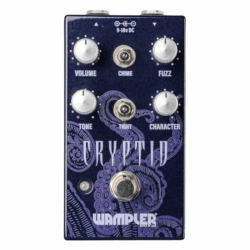
Wampler Cryptid Review
Since hitting the scene in 2007, Wampler has consistently made some of the better overdrive and distortion pedals on the market. Interestingly, though, other than 2013’s Levithan fuzz and its brazen sibling, the Fuzztration, which is a fuzz/octave pedal, Wampler’s product line didn’t feature many fuzz pedals. Since then, Brian Wampler has evolved as a pedal builder, and Wampler’s new Cryptid reflects a unique take on what a fuzz can be—employing a newly designed circuit with NPN and PNP transistors, and FETs.Wampler has described the Cryptid as a “fuzz for those who don’t like fuzz.” And certainly, it’s a versatile pedal that covers much more sonic ground than conventional fuzzes. In addition to delivering variations on familiar classic Fuzz Face, Tone Bender, and Big Muff sounds, the Cryptid can move into light overdrive or even chiming clean territory. A Fun House of FuzzThe Cryptid, despite the implied mystery in its name, is pretty forgiving. You could just set all the knobs at noon and you’d be good to go for any number of fuzz tasks and roles. But this is a fuzz of impressive potential, and every knob and switch—particularly the character knob and the tight and chime switches, and the way they interact—can profoundly reshape the pedal’s performance and feel.The character knob is a bias control that can shift the mood and responsiveness of the pedal significantly. When the character knob is fully counter-clockwise, the Cryptid is well behaved and focused. As you turn it clockwise, though, things get crazier. Once the character knob is around 2:00 you’ll start to hear sputtering textures that evoke tired, voltage-starved vintage units and more deliberately designed glitch fuzz.The tight switch lets you regulate how much bass is present in the signal and has a pretty significant impact on the tone. In the down position, it adds in a fair amount of bass. The middle position offers the least bass content and tightens up the sound, which brings out more overdrive-like colors. The up position is the ticket to maximum bass, and even with the fuzz knob set conservatively the Cryptid really is explosive and massive.The chime switch adds high end. The down position gives a little bit of chime, the middle position is relatively chimeless and has a darker quality, and the up position yields the brightest sounds. The less fuzz you apply to the signal, the more noticeable the chime effect will be. With the fuzz knob all the way counter-clockwise and the chime control switch in the up position, you get delicious, pronounced near-clean tones that fit the bill for Hendrix double stops and Stevie Ray Vaughn blues escapades.Brian Wampler’s ambitions in putting together the Cryptid—essentially encapsulating the character and tonalities associated with Big Muffs, Tone Benders, and Fuzz Faces, while leaving room for airy, cleaner tones and picking dynamics—were far-reaching. But there is ample evidence that he achieved his aims. Cryptid may not serve many purists searching for classic clone sounds, but it offers the chance to create more original sounds that have all the fire of those classics, and more polite tones to boot.
Read more »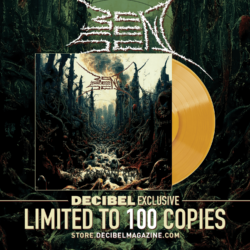
Track Premiere: Bent Sea – “A Scopic Radiance”
Hear the latest single from All-star grindforce Bent Sea before their debut LP The Dormant Ruin is released this Friday via Give Praise Records.
The post Track Premiere: Bent Sea – “A Scopic Radiance” appeared first on Decibel Magazine.
Blast Worship: Agonized
Hear Malaysian grindcore force Agonized bring the pain via the self-released Absence of Truth.
The post Blast Worship: Agonized appeared first on Decibel Magazine.
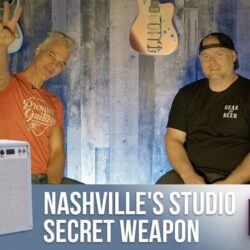
From Metal Crunch to Country Clean: The Rise of Revv Amps
John Bohlinger sits down with Revv Amps’ cofounder Derek Eastveld to trace the company’s journey from basement builds to pedal boom. And while their Generator Series fire-breathing amps and pedals started its ascent finding homes with rockers The Pretty Reckless & A Day to Remember, Eastveld explains that it might be their clean, versatile Dynamis Series gear that’s making the Canadian brand a preference for players and producers in Nashville.
Read more »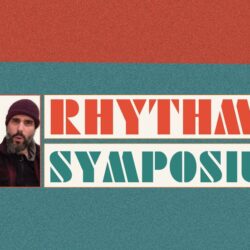
Ella Feingold and Charlie Hunter: A Rhythmic Symposium
When it comes to rhythm guitar, there are acknowledged masters—artists like Jimmy Nolen, Catfish Collins, Wah Wah Watson, Curtis Mayfield—whose work deserves deep analysis and interpretation. But the discourse on each and every one of these players is sadly thin. That’s because rhythm—especially when it’s funky—is ineffable, and it’s much easier to discuss licks, riffs, melodies, or gear than it is to talk about the give-and-take nuances that make your body want to move when you hear a song. Like Icarus and the sun, if we try to describe a groove too closely we’re setting up our demise. In the attempt to convey those truly human elements of musical performance, we not only fail, but risk rendering ourselves … unfunky.YouTubeIt’s not just words that fall short—musical notation can’t quite capture a groove either. Though it does well at communicating a composer’s intended notes and rhythms, transcribing the intricacies of feel is a task that often overcomplicates something so intrinsic to human nature to the point of illegibility. In learning from the greats of funk, soul, and r&b guitar, we simply have to use our ears as best we can.“I think we probably share like 60 to 75 percent of our musical DNA. And then the extra stuff that we have adds something to it.” —Charlie HunterFor some, that only goes so far, so we need visual aides. And that’s how most people—probably—discover Ella Feingold, the Grammy-winning guitarist breaking down the intricacies of those masters of rhythm guitar and many others on Instagram and TikTok, making some of the greatest strides yet in the education—and enjoyment—of funky feel. We’re talking deep, below-the-surface details, like pick attack and note placement—potentially nerd-level stuff that she delivers in a warm, approachable style that makes her videos so engaging and rewatchable. (In fact, if there’s one person I’ve learned the most about guitar from in the last couple of years, it is Ella.)Feingold’s rhythmic research is backed by a deep resume that spans work as an orchestrator, composer, and producer. As a guitarist, Feingold has been tapped to play alongside an impressive list of leaders that includes Erykah Badu, Silk Sonic, Bootsy Collins, and Jay-Z. Charlie Hunter is one of many who found Feingold through Instagram. After Hunter—who came up in the ’90s on Blue Note Records, famously wielding a hybrid guitar/bass instrument that set the jazz-funk scene on high alert—scrolled across Feingold’s videos, the two quickly took it to their DMs and established a friendship. Collab talks started soon after. Feingold, who has worked exclusively as a side musician save for a few classical piano pieces, jumped at the opportunity to release a record under her name alongside Hunter, who she lovingly calls “a musical hero.”
The two convened at Pilot Studios in Great Barrington, Massachusetts, with producer Alan Evans—best known as the drummer for Soulive—for a few short days to create Different Strokes for Different Folks, a rhythm symposium of the highest order. It’s a record that’s earnestly old-school by way of a simple approach: capturing a live-off-the-floor two-way conversation between singular instrumentalists. Feingold’s guitar—punchy and percussive but still delicate and detailed—lies on the right side of the stereo field throughout, communing with Hunter’s counterpoint of pulsing bass, which sits near the center, and snare-like guitar chords and knotty riffs on the left. No-frills drums, added by Hunter, pull together the sound, unifying the feel and tying the record to groove masters like Stevie Wonder and Sly Stone—the latter referenced in the album title and its opening track, “There’s Still a Riot Goin’ On.”
“Sly is just my god, my king of dark funk.” —Ella FeingoldDifferent Strokes for Different Folks is a masterwork of minimal funk: there are no solos, and melodies arise from rhythm itself. It’s an album that draws attention to the finer details of rhythm guitar, and to the communication between rhythmic elements that are often relegated to background duty. Most importantly, it’s an album that will make you feel something.
We got together with Feingold and Hunter to talk rhythm, recording, and the art of musical conversation.After first meeting on Instagram, what was the catalyst for making the record happen, and how did it come together?Ella Feingold: I’ve always been a fan of Charlie’s, obviously. Eventually, it led to just talking all the time, about rhythm and all the stuff we love that doesn’t really get discussed a lot. We had a lot in common, and at some point, he’s like, “Yeah, we should make a record together…” which kind of terrified me.Charlie Hunter: I think we probably share like 60 to 75 percent music DNA. And then the extra stuff that we have adds something to it. I have all this really old knowledge that nobody cares about, like 1920s stuff. And then I always tell people, “You want to know about this one Motown recording from 1968?” Call Ella, because she’s going to know exactly who played on that and exactly every part. Feingold: We knew we wanted to do a record together. But in terms of the drumming, we had talked about everything from programming an MPC to just having a funk box—a Rhythm King, a Rhythm Ace—to getting drummers. We had talked to Steve Jordan, and Steve was like, “I’m down.” We had talked to Questlove, Questlove was down. And I know this sounds like the douchiest thing in the world to say—because to have musicians like that that are interested in working with us is the grandest honor—Charlie and I, we just wanted the conversation to be between the two of us. We wanted the rhythm to be this mantra that feels good, that moves you to the conversation we’re having, but that’s not the forefront of the conversation.So it started with us going in, knowing that the rhythm is going to come from him and I, but not exactly sure how. And then with me programming a little bit with the MPC and playing along. Then Charlie replaced everything and killed it on drums. So Charlie’s the drummer on the record. And what I think is cool about that is we wanted it kind of like … when Sly Stone plays drums, and when Stevie Wonder plays drums, or when Lenny Kravitz, whoever, like an artist that plays their own music, does the drum part, it’s going to be exactly what it needs to be and nothing else, with no other filler, no other musicianship, no “look what I can do.” It’s going to be exactly what needs to be there. And that’s exactly what Charlie did.Hunter: Because I don’t take pride in my drumming, we wanted it to just be as basic as possible.Ella, there are so many songs you talk about on your social media that I’ve heard a million times, but you’ll show how a part goes and then I’ll hear it so differently. It blows my mind. You have such a good ear for really fine details, and I know a lot of people feel that way.
Feingold: I feel like I get too much credit. A lot of that stuff just comes from what I can’t do—meaning I don’t really solo, I don’t know modes, I don’t really know a lot of scales. There’s so much I don’t know. My ear just goes to the place that makes my ear happy.
I think some of it has come from being on the road in the early 2000s, when there were no stems, no stem-making software, there wasn’t really social media. You had to learn a show from a rehearsal CD or an MP3 and had to pick out guitar parts. You really had to do this kind of deep listening to try and hear stuff.“If you have a good feel and something to say and a lived experience, you got this.”—Ella FeingoldThere are two references to Sly Stone on the album—the title is a lyric from “Everyday People,” and the song “There’s Still a Riot Goin’ On” is a hat-tip to Sly’s 1971 record.
Hunter: That’s Ella’s department. She is a Sly-o-phile.
Feingold: Sly is just my god, my king of dark funk. You obviously have George Clinton and James Brown, but something about Sly, for me, it’s just the greasiest, most raw, tasteful … it’s something that just hits me in the chest. A lot of my musical aesthetic was from Sly and from him playing all the instruments. And then all the music I adore—D’Angelo and J Dilla and some Prince—it all comes from Sly.
If I can get political, I’m a trans woman, and we did that album in February, a month after the inauguration, after Trump was going after trans people, taking away life-saving medicine and hormones and fucking with our passports and all kinds of stuff. And I felt a lot of turmoil. So going into the record, it just felt like there was a riot going on—externally in the world and internally within. And I just wanted some of that to be reflected in the conversation. Not just because I love Sly and the Sly references. Certainly “different strokes for different folks” came out of the lyrics, but it’s cool because “different strokes” can also be referring to Charlie’s stroke and my stroke on the instrument, and there’s also the Muhammad Ali reference—knocking people the fuck out.Tell me about the guitars you used on the record, and the tunings.Feingold: I used a Mexican Strat in inverted tuning—it’s E–A–D–G–B–E, but it’s high to low, not low to high, so familiar voicings become distant relatives. Where did the inverted tuning come from?Feingold: From my buddy Blake Mills [who learned it from Chris Weisman]. I even have the text message where he said, “I’m about to change your life.” For me, the appeal was it gave me the rhythm sound I wanted in terms of attacking the high strings first. And the tuning felt a little familiar, because it’s related to standard. Although anything above a triad, the overtone series sort of gets put on its head—all the color tones are on the low strings and all the roots and thirds are on the high strings. But it opened up this whole new world of harmony that was like Claus Ogerman harmony—close position stuff you’d hear Nat King Cole or George Shearing play. What I love is it’s sort of similar to Charlie’s whole journey, which he took long before I did, of, “What does this thing want to be?” And then finding a sound with it.“The first time we played, I was like, ‘This sounds like a gigantic lawnmower guitar that can take buildings down.’” —Charlie HunterHunter: I think there’s also something really special that happens because of Ella’s inverted tuning and the fact that it’s basically in E, while my hybrid tuning is basically an F. Every tune, we each have a different set of open notes and a different overtone series that makes the instruments do this really cool shimmery thing together. The first time we played, I heard that and I was like, “This is dope. This sounds like a gigantic lawnmower guitar that can take buildings down. All right, let’s go do this.”Charlie, your journey with your instrument has been well documented at this point, but catch us up a little bit.
Hunter: I started on this 8-string guitar, and that was really a bad idea. And I made a bunch of records on it. I just was like, “Hey, Ralph Novak [of Novax Guitars], can you make this? I have an idea. Could be cool.” Never thinking this was going to be my career. Before I knew it, I had a deal with Blue Note. And then I’m like, “My god, I can’t really do this very well. It’s so hard. What am I doing?” It took me years to figure out, “What does this instrument want to do?”
So I hooked up with Hybrid Guitars and I settled on this thing I’m calling the Big 6. What this instrument does best is really more like a drum set, where you have bass and guitar and it’s all about the counterpoint. It has an extra long scale—the lowest string is 31 inches and the highest is 28.
I have it tuned F, Bb, Eb—which are the lower three strings of a bass, up a half-step—which sends me into a hell of transposition, but sounds so much better than E. And the guitar [side] is Bb, Eb, Ab, which is essentially A, D, G up a half-step.Ella Feingold’s Gear GuitarFender Jimi Hendrix Stratocaster with Fender Custom Shop Fat ’60s pickups and inverted tuningAmp1968 Fender Princeton ReverbEffectsEnsoniq ASR-10 used for envelope filter Strings and PicksLa Bella inverted tuning custom signature set (.046 E; .032 B; .017 G; .026 D; .016 A; .011 E)D’Addario Ukulele 3.0 mm Charlie Hunter’s GearGuitarHybrid Guitars Hybrid 6 (aka Big 6)AmpTwo-Rock Studio SignatureAmpeg B-15Acme Audio Motown DIEffectsSurfyBear Compact DeluxeStringsThomastik-Infeld Jazz Flat Wound (bass side)Thomastik-Infeld Pure Nickel Round Wound (guitar side)What was the biggest revelation that came from working together?
Hunter: For me, it’s just that we have a great time playing together, and I just learned a ton, you know? And if I can take that away from any situation, it’s a win.
Feingold: The gift of working with Charlie is it gave me the confidence to make my own music. Because I’ve spent my entire career helping other people with their music, playing on their records or producing. I’ve never invested in my own music because I always thought you have to make your own, like, Pet Sounds or Sgt. Pepper’s—you’re going to be working, writing for years. And it was like, we went in there, we had some ideas over a couple of months, and it turned into over an hour of music.
And it just was like, “Wow, I’m overthinking this stuff like crazy.” If you have a good feel and something to say and a lived experience, you got this. That was kind of an unexpected gift. After Charlie and I finished mixing the record, I bought a four-track and I made an EP. I was really inspired by just being around Charlie.
So if you have something to say in the moment, that’s it. That’s the most important thing.
